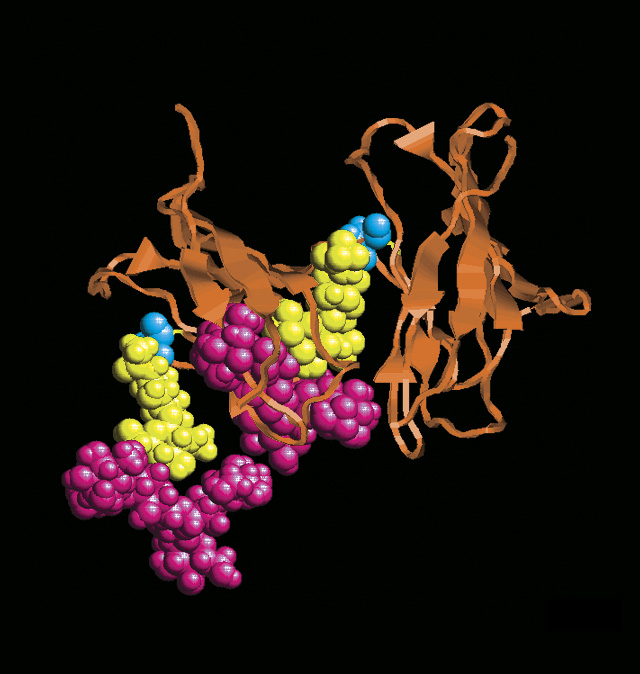
**This webpage was produced as an assignment for an undergraduate course at Davidson College**
Evasion of Immune System
HSV is a “smart” virus in that it has evolved many ways to evade the human immune system, and both general tactics and specific molecules aid in its evasion of the immune system.
General Tactics
Location
HSV establishes latent infection in neurons, which were previously not thought to be monitored by the immune system (Da Costa et al. 1999). Additional studies have shown that CD8+ T cells monitor the immune system, but neurons are a good location in attempting to avoid immune detection. In addition, neurons do not divide, which allows the viral genome to avoid complete replication in order for the virus to live in the neuron for the lifetime of the cell (Bystricka and Russ 2005). In addition, the virus does not produce measurable antigens in the latency period, or if it does, the levels are very low (Da Costa et al. 1999).
Suppression of host gene expression
When a cell is infected with HSV, the protein synthesis of the cell is fully suppressed. mRNA levels decrease, the translational apparatus is nonfunctional, and RNA polymerase stops cellular gene transcription and induces viral IE gene transcription (Smiley et al. 2004). HSV infection also adversely affects mRNA splicing, and many host genes have introns that must be spliced (whereas HSV genes contain few introns). The IE gene ICP27 is required for the inhibition of mRNA splicing (Smiley et al. 2004).
Multiple receptors
HSV can infect epithelial cells using a variety of different receptors, including heparan sulfate, HVEM, and nectin-1 and nectin-2. Spear et al. (2004) argue that “the ability of HSV-1 and HSV-2 to use multiple receptors for entry into cells could in part reflect simple redundancy but there may be greater significance to the existence of multiple receptors.” The ability of HSV to enter through multiple receptors allows them to enter different cell types, and this is important for the different periods of the viral lifecycle. For example, HVEM but not nectin-1 is expressed on T cells (Spear et al. 2004). Also, viruses can enter the same cell type under different conditions. For example, unless cells are damaged, nectin-1 and nectin-2 are inaccessible to HSV, so HSV must enter the cell using HVEM. However, nectin-1 and nectin-2 allow for HSV to infect additional epithelium in a cell-to-cell fashion (Spear et al. 2004).
Specific Molecules
gC
gC is a glycoprotein (see Figure 1) expressed on the HSV cell surface, and it can bind to C3b, a member of the complement system, to protect the virus from neutralization by components of the complement system (Friedman 2003). Viruses that lack gC are “more sensitive to complement lysis” (Lubinski et al. 1998- add to references). Recent studies on the virulence of gC-null virus have been conflicting, but it is likely that gC plays a role in evading the innate immune response (Spear et al. 2004).

Figure 1. Structure of a glycoprotein. Image from http://www.apollocytokineresearch.com/Scientific/glycosylation.html
vhs
The Virion Host Shutoff (vhs) protein is located in the tegument and is encoded by UL41, and it probably helps HSV evade both the innate and adaptive immune responses (Smiley et al. 2004). It serves as an RNase that turns off protein synthesis in the host cell, degrades the host’s mRNA, and destroys existing ribosomes (Smiley et al. 2004). Mouse mutants that lack vhs have difficulty replicating (Smiley et al. 2004- correct?). vhs contributes along with ICP47, an immediate early gene, to prevent MHC class I expression on host cells and inhibit cytotoxic lymphocyte action on the infected cell (Smiley et al. 2004). ICP47 accomplishes this by blocking peptide transport into the endoplasmic reticulum through binding to TAP and consequently inhibiting viral peptides presentation to MHC class I (Hill et al. 1995). vhs also assists in reducing levels of MHC class II expression (Trgovcich et al. 2002- Smiley 2004). vhs also suppresses production of cytokines and chemokines and inactivates human monocyte-derived dendritic cells (Smiley et al. 2004).
gE-gI Heterodimer
The glycoproteins gE and gI form a heterodimer that inhibits viral neutralization by binding to the Fc region of IgG molecules (Johnson et al. 1988).
Summary of Immune Evasion Viral Molecules
Viral Molecule |
Effect |
gC |
- binds to C3b to prevent complement neutralization |
vhs |
- suppresses MHC class I and II expression - suppresses cytokine and chemokine production - turns off protein synthesis in host cell - degrade host cell’s mRNA |
gE-gI heterodimer |
- binds to the Fc region of antibodies to prevent virus neutralization |
Davidson College Biology Department
Contact jehodge@davidson.edu with questions or comments.